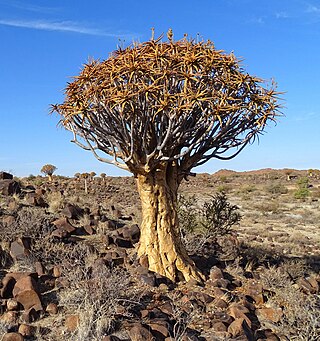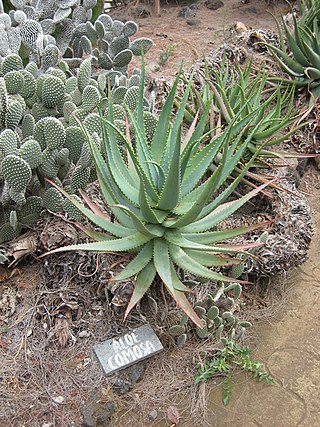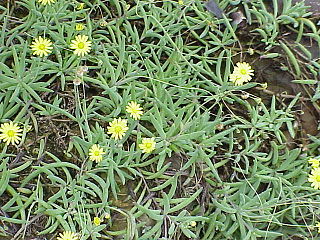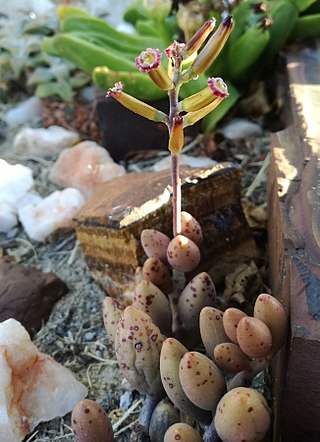
Cyphostemma juttae is a slow-growing succulent species of Cyphostemma from southern Africa, well known as an ornamental plant.

Aloidendron dichotomum, formerly Aloe dichotoma, the quiver tree or kokerboom, is a tall, branching species of succulent plant, indigenous to Southern Africa, specifically in the Northern Cape province of South Africa, and parts of Southern Namibia.

The Brandberg is Namibia's highest mountain.

Aloe arborescens, the krantz aloe or candelabra aloe, is a species of flowering succulent perennial plant that belongs to the genus Aloe, which it shares with the well known and studied Aloe vera. The specific epithet arborescens means "tree-like". Aloe arborescens is valued by gardeners for its succulent green leaves, large vibrantly-colored flowers, winter blooming, and attraction for birds, bees, and butterflies.

Othonna is a genus of approximately 90 species of succulent or subsucculent perennial herbs or shrubs, with its center of diversity in the Greater Cape Floristic Region (GCFR) of South Africa but some species' ranges include southern Namibia, Angola, and Zimbabwe. The genus was established by Linnaeus in 1753 containing 14 species, however, of those original species, only four are still retained in Othonna, while the others have been transferred to different genera including Cineraria, Euryops, Hertia, Ligularia, Senecio, and Tephroseris. The genus Othonnna is known to be monophyletic. In 2012, a new genus Crassothonna B. Nord. was erected with 13 species transferred from Othonna. A complete modern taxonomic treatment of the genus is being undertaken by the Compton Herbarium and the South African National Biodiversity Institute. The first part, a revision of the Othonnna bulbosa group, was published in 2019.
Lomanthus fosbergii, synonym Talamancalia fosbergii, is a species of flowering plant in the family Asteraceae endemic to Ecuador. Its natural habitat is subtropical or tropical moist montane forests. It is threatened by habitat loss. It was first described by José Cuatrecasas in 1953 as Senecio fosbergii. The genus Lomanthus is placed in the tribe Senecioneae.

Aloe comosa is a species of flowering plant in the Asphodelaceae family. It is commonly called Clanwilliam aloe) and is endemic to South Africa.

Gonialoe dinteri, the Namibian partridge aloe, is a species of flowering plant in the Asphodelaceae family. It is native to arid areas of Angola and Namibia.

Aloidendron pillansii, formerly Aloe pillansii, the giant quiver tree or bastard quiver tree, is a large, branching species of succulent plant indigenous to southern Africa. It is regarded as critically endangered.

Aloidendron ramosissimum, or the maiden’s quiver tree, is a species of succulent flowering plant in the family Asphodelaceae, placing it alongside such genera as Aloe, Alstroemeria, Bulbine, Gasteria, Haworthia, Hemerocallis (daylilies), Kniphofia and Phormium, among others. Despite its smaller size, when compared to related species, it is sometimes referred to as a "tree-aloe". It is endemic to the Richtersveld, at the border between northwestern South Africa and southern Namibia, where it grows on desert slopes and in ravines, as well as some open, flat areas. In Namibia, it is known from the southern inland Ilkaras (Karas) Region, north of the border with South Africa. Its range continues into the Northern Cape province, having been observed as far south as Springbok.

Juttadinteria deserticola is a species of plant in the family Aizoaceae that is native to Namibia and South Africa.

Rune Bertil Nordenstam is a Swedish botanist and professor emeritus at the Swedish Museum of Natural History in the Department of Phanerogamic Botany. He has worked with Colchicaceae, Senecioneae and Calenduleae, was the editor of Compositae Newsletter newsletter since 1990, and is a Tribal Coordinator for The International Compositae Alliance with responsibility for the tribes Calenduleae and Senecioneae.

Crassothonna capensis, also known as little pickles (USA), ruby necklace (Australia), Cape aster, Cape Othonna, and Bobbejaankool (Afrikaans), is a species of the genus Crassothonna previously (Othonna) in the family Asteraceae, and is a native of the Eastern Cape of South Africa. It is a native highveld species that originates from the southern Drakensberg region.

Curio archeri, syn. Senecio toxotis is a species of succulent plant in the family Asteraceae that is indigenous to the south-western Cape, South Africa.

In botany, succulent plants, also known as succulents, are plants with parts that are thickened, fleshy, and engorged, usually to retain water in arid climates or soil conditions. The word succulent comes from the Latin word sucus, meaning "juice" or "sap".

Senecio cadiscus is a species of aquatic flowering plant in the aster family, Asteraceae. It is endemic to the Western Cape of South Africa, where it grows in vernal pools. It was at one time classified as Cadiscus aquaticus, the only species in the monotypic genus Cadiscus, but molecular phylogenetic analysis showed that it is nested within Senecio. It is a floating or emergent plant with small narrow leaves and white-rayed flowers. Its populations are small and fragmented, and are declining. The plant is threatened by grazing and trampling by livestock, invasive plants, reclamation of wetlands and eutrophication from fertilizer runoff. The International Union for Conservation of Nature has consequently rated it as "critically endangered".

Aloe pearsonii is a very distinctive and unusual species of aloe, that is naturally endemic to the arid Richtersveld area on the border between South Africa and Namibia.

Caputia is a small genus of flowering plants in the family Asteraceae, native to South Africa. It may be of hybrid origin. Species in this genus were formerly considered part of the genus Senecio.

Crassothonna is a genus of flowering plants belonging to the family Asteraceae.

Adromischus filicaulis is a perennial, succulent plant in the family Crassulaceae. It is commonly called brosplakkies in Afrikaans. The species is endemic to South Africa and Namibia.




















